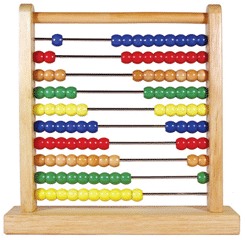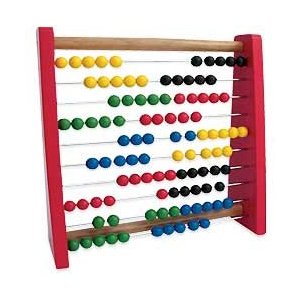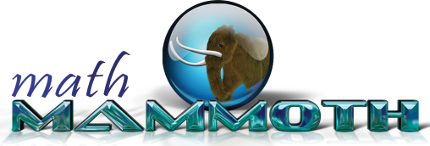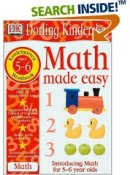Kindergarten math — overview and recommendations for workbooks & worksheets
This is a comprehensive article about all aspects of kindergarten math, with recommendations for workbooks, and lists of free worksheet resources.
Disclosure: I get commissions for purchases made through Amazon links on this page.

Counting
A 100-bead abacus
Number recognition
Worksheets for shapes, matching, equivalence, etc.
Kindergarten workbooks
The goal of kindergarten mathematics is to prepare children for first grade math. Please see below a list of objectives and goals for kindergarten math:
- To count by rote at least to 20, but preferably a little beyond.
- The concepts of equality, more, and less
- To count backwards from 10 to 0.
- To recognize numbers
- To be able to write numbers
- To recognize basic shapes
- to understand up, down, under, near, on the side, etc. (basic directions)
- To understand the concepts of addition and subtraction with small numbers
- Expose the student to two-digit numbers.
Children may also get started with money, time, and measuring, though it is not absolutely necessary to master any of that. The teacher should keep it playful, supply measuring cups, scales, clocks, and coins to have around, and answer questions.
During 1st grade, children will then learn addition and subtraction facts, two-digit numbers, some adding and subtracting with two-digit numbers, and some basics of measuring, time and money.
Counting
Mathematics starts with COUNTING. Let children count all kinds of things they see or use. Use simple counting games, such as:
- Have a deck of regular playing cards minus the picture cards. Each person draws a card. The one with a higher number wins all the cards played in that round. This can teach both number recognition and counting, because the child can count those little pictures (hearts, spades, clubs, or diamonds) on the card.
- A variation of the one above: deal two cards to each person. The person with a higher TOTAL wins all the cards played in that round. Children will learn basic addition!
- Use any board game. Have the markers advance as many steps as a die or dice show. The child will need to count the dots on the die or dice, and then count steps to move his marker.
- Lay a bunch of dominoes face down on the table. A child picks one, you pick one. The person with a higher "dot-count" gets both dominoes.
- Lay a bunch of dominoes face UP on the table. A child picks one and places it on the table to start the "train". The next person picks one so that its end matches one end of a domino already laid.
- Play with marbles or blocks or similar objects. You take some objects, and ask the child to take for himself as many as you have AND ONE more. Then it's the child's turn to take some, and you need to take the same amount plus one more. Reverse the game later to do ONE LESS.
- From counting you can go on to simple addition and subtraction with small numbers. The idea is to teach the child the CONCEPTS of addition and subtraction, and not to worry about memorizing addition and subtraction facts (those come in 1st and 2nd grades). You can for example use this simple bus activity where people come in (or go out of) the bus on different bus stops to illustrate the meanings of addition and subtraction.

A 100-bead abacus
One extremely helpful manipulative to buy is a basic 100-bead abacus (10 racks, 10 beads in each). This is the prime "toy" to teach numbers beyond ten. With such an abacus children will naturally learn their "tens and ones". I've written about the usage of abacus for learning place value here.
The best kind of abacus has each five beads in alternating colors, like the abacus from Schylling you see on the right.
If you can't get one with 5 and 5 beads in different colors, then get a regular abacus with 10 beads in each row, such as Melissa & Doug classic wooden abacus.
You can browse Amazon's abacus selection here
.
Number recognition
It is helpful to have concrete numbers (plastic or foam) that the children can touch. Other than that, games are again an excellent way to reinforce learning.
- Here's a simple game: Have a bunch of foam numbers
and/or plastic magnetic numbers
, and make a heap of them between you and the child. You pick one, hold it up high and call out loud its name, such as "Number five!" and put it to your personal pile.
The child will then find the same number (make sure there are at least two of each number) and does the same, calling its name out loud and gathering the number to himself.
Then you reverse it so that it is first the child's turn to pick any number from the pile, call out its name, and put it to his pile, and you have to find the same number. After all the numbers in the middle pile were gone, the task is to arrange the numbers you have in order.
- Play all kids' favorite card game: UNO
. That'll motivate children to learn to recognize numbers quickly.
- Check my list of online addition and subtraction games.
Worksheets for shapes, matching, equivalence, more, and less
To recognize shapes and practice matching, you can either use ready-made worksheets or workbooks, or make some of your own.
If you make your own, you can just draw three circles on a page and then 2-5 triangles on a page, and ask the child to match each circle with a triangle by drawing a line from shape to shape. Vary the shapes and the amounts. Sometimes the amounts should be equal, sometimes not.
Another variation is to ask the child to draw. First make some sticks, circles, squares, or other shapes on a page, and encircle them. Make for the child a big "bubble" to draw in, and ask the child to draw either the same amount, one more, or one less.
Also have your child practice writing numbers on paper.
Kindergarten math workbooks
I like to recommend Math Made Easy: Kindergarten Workbook by Dorling Kindersley as it's of good quality and simple to use. The whole series of Math Made Easy workbooks is quite good.
Evan-Moore always publishes quality materials and their kindergarten workbook is no exception.
Yet another kindergarten math workbook to consider is Singapore Math — their EarlyBird Kindergarten Mathematics is praised a lot.
You can find lots more kindergarten math workbooks at Amazon. You don't need anything too fancy to practice these concepts, so workbooks from many different publishers can work equally well.
Additionally, these major educational publishers have a lot of kindergarten workbooks :
Evan-Moor Educational Publishers
Free worksheets
Many websites offer free materials for kindergarten math:
- Activities from Early Family Math — these include puzzles, games, and other activites you can do together with your child.
- Kidzone.ws kindergarten math worksheets
- Maths is fun kindergarten worksheets
- Education.com free kindergarten worksheets
- Addition and subtraction worksheets from DadsWorksheets.com
- PRINT Handwriting Practice Worksheet program — you can use these to help children practice writing of numbers.
- Use puzzles and activities to help develop the child's logical reasoning. Check out for example these easy animal dot-to-dots made by my daughter!
PrimaryLearning offers a large collection of kindergarten worksheets also; however you need a paid subscription to access them.
Math Mammoth 1st grade
A child is ready for Math Mammoth complete first grade curriculum (Light Blue series) once he/she:
- can write numbers
- can count well at least to 10 and back, but preferably to 30 or more
- has some idea about two-digit numbers
- understands the basic concept of addition and the written notation
- understands the basic concept of subtraction and the written notation
If you don't want to get a complete curriculum but prefer shorter books, then check out Addition 1 in Math Mammoth Blue Series as it is the first and easiest book of that series, suiting the beginning of 1st grade.
Both the 1st grade complete curriculum and the Addition 1 book start out dealing with addition within the range 0-10, but they also include missing addend problems such as 3 + __ = 7 and word problems. Kindergartners or younger children MAY get confused with the missing addend concept. If that happens, don't worry – just wait and let the child's brain mature.
By Maria Miller
Receive my monthly collection of math tips & resources directly in your inbox — and get a FREE Math Mammoth book!
You can unsubscribe at any time.
Math Mammoth TourConfused about the different options? Take a virtual email tour around Math Mammoth! You'll receive: An initial email to download your GIFT of over 400 free worksheets and sample pages from my books. Six other "TOURSTOP" emails that explain the important things and commonly asked questions concerning Math Mammoth curriculum. (Find out the differences between all these different-colored series!)This way, you'll have time to digest the information over one or two weeks, plus an opportunity to ask me personally about the curriculum. A monthly collection of math teaching tips & Math Mammoth updates (unsubscribe any time) We respect your email privacy.
Note: You will FIRST get an email that asks you to confirm your email address. If you cannot find this confirmation email, please check your SPAM/JUNK folder. |
"Mini" Math Teaching CourseThis is a little "virtual" 2-week course, where you will receive emails on important topics on teaching math, including:
- How to help a student who is behind You will also receive: A GIFT of over 400 free worksheets and sample pages from my books right in the very beginning.We respect your email privacy.
Note: You will FIRST get an email that asks you to confirm your email address. If you cannot find this confirmation email, please check your SPAM/JUNK folder. |
Maria's Math TipsEnter your email to receive math teaching tips, resources, Math Mammoth news & sales, humor, and more! I tend to send out these tips about once monthly, near the beginning of the month, but occasionally you may hear from me twice per month (and sometimes less often). Peek at the previous tips here. You will also receive:
We respect your email privacy.
|
|


